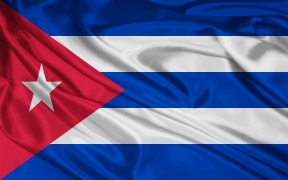By Daniel Nardini
 Just a few days after our tour group arrived in Cuba, half the group got eye infections. The tour operators were so worried that they took all of us to a clinic not far from our hotel. Those of us who had eye infections got off the bus and went to the clinic (fortunately, my eyes were fine). After about an hour and a half, those who went to the clinic boarded the bus and we all went to our next tourist destination. Those of us who stayed on the bus asked what the clinic was like. We were shocked to hear in detail what the clinic was like and did not have. The clinic had dirty walls, bare chairs, and old American-made medical equipment from the 1950’s. There were no medicines, no bandages, and not even bottles of aspirin. The only thing the clinic had were eye drops. This is what the doctor used to aid the patients. The eye drops came from the Soviet Union, and the eye dropper bottle looked old. To put it mildly, many of the tourists who were in the clinic were disappointed at the medical facilities. Some of them commented that back in the United States they might have done better to have bought the eye drops they needed at a local pharmacy.
Just a few days after our tour group arrived in Cuba, half the group got eye infections. The tour operators were so worried that they took all of us to a clinic not far from our hotel. Those of us who had eye infections got off the bus and went to the clinic (fortunately, my eyes were fine). After about an hour and a half, those who went to the clinic boarded the bus and we all went to our next tourist destination. Those of us who stayed on the bus asked what the clinic was like. We were shocked to hear in detail what the clinic was like and did not have. The clinic had dirty walls, bare chairs, and old American-made medical equipment from the 1950’s. There were no medicines, no bandages, and not even bottles of aspirin. The only thing the clinic had were eye drops. This is what the doctor used to aid the patients. The eye drops came from the Soviet Union, and the eye dropper bottle looked old. To put it mildly, many of the tourists who were in the clinic were disappointed at the medical facilities. Some of them commented that back in the United States they might have done better to have bought the eye drops they needed at a local pharmacy.
This, to coin a pun, was an eye-opening experience. Why were ordinary Cuban medical clinics in such poor shape? Why did they lack even the most basic medicines and medical supplies such as aspirin, gauze, bandages, or antibiotics? Why were things that Americans can buy in a pharmacy not available in Cuban clinics and hospitals? At first, many of us tourists thought that this was due to the U.S. embargo against Cuba. Our tour guides alluded to this. However, I learned after returning from Cuba that medicines, medical supplies and humanitarian aid is excluded from the U.S. embargo against Cuba. So, why didn’t the Cuban government get all of the medicines and medical supplies necessary for the people? I saw the Cuban hotel rooms have air-conditioners, shower sprinklers, and even lawn equipment made in Japan. These things were definitely on the U.S. embargo list, but it seemed that the Cuban hotels had enough of these things. In my mind, the Cuban government (and we have to remember that the Cuban government manages all of the tourist facilities in Cuba) has put in the money for the hotels, motels and travel vehicles such as tourist buses so that tourists can “enjoy themselves” and spend badly needed hard currency in Cuba. Meanwhile, ordinary Cubans could not get even basic health care.
This was in 1981. Decades later, this is still true. Recent reports have peeled back the reality of what Cuban clinics and hospitals are like for the ordinary people. Only special people can get the best in Cuba, and these include Communist party officials, foreign embassy personnel, and visiting dignitaries. Back then, almost no Cuban doctors, nurses or medical staff were ready to come forward and tell the world what conditions were really like in Cuba’s much vaunted health care system. This has changed. Now there are Cubans who have worked in the health care industry, who have left family and friends and everything they ever knew behind, are telling the world how bad the health care system is for ordinary Cubans. And the decrepit state of Cuban health care remains as bad as ever because the Cuban government is the problem. It gives low to no priority for its people. It both saddens and sickens me that there are those on the political left in the United States who still think and say that Cuba’s medical system is “among the best in the world.” These same people rail against America’s health care system, and its fundamental inadequacies. There is no doubt in my mind that America’s health care system has some serious problems. But at least we have all the medicines, all of the medical supplies, and all of the best medical equipment available. We do not have dirty, bare clinics, and as Americans we are not afraid to complain what we think is wrong. What have the Cubans got?
 Property Tax Savings Available for Veterans April 17, 2025
Property Tax Savings Available for Veterans April 17, 2025 Pilsen to Host Annual Procession on Good Friday April 17, 2025
Pilsen to Host Annual Procession on Good Friday April 17, 2025
 Moulin Rouge! The Musical in Chicago April 17, 2025
Moulin Rouge! The Musical in Chicago April 17, 2025 Move Over or Get Pulled Over April 17, 2025
Move Over or Get Pulled Over April 17, 2025





How Cuba’s Health Care System Really Stinks
By Daniel Nardini
This, to coin a pun, was an eye-opening experience. Why were ordinary Cuban medical clinics in such poor shape? Why did they lack even the most basic medicines and medical supplies such as aspirin, gauze, bandages, or antibiotics? Why were things that Americans can buy in a pharmacy not available in Cuban clinics and hospitals? At first, many of us tourists thought that this was due to the U.S. embargo against Cuba. Our tour guides alluded to this. However, I learned after returning from Cuba that medicines, medical supplies and humanitarian aid is excluded from the U.S. embargo against Cuba. So, why didn’t the Cuban government get all of the medicines and medical supplies necessary for the people? I saw the Cuban hotel rooms have air-conditioners, shower sprinklers, and even lawn equipment made in Japan. These things were definitely on the U.S. embargo list, but it seemed that the Cuban hotels had enough of these things. In my mind, the Cuban government (and we have to remember that the Cuban government manages all of the tourist facilities in Cuba) has put in the money for the hotels, motels and travel vehicles such as tourist buses so that tourists can “enjoy themselves” and spend badly needed hard currency in Cuba. Meanwhile, ordinary Cubans could not get even basic health care.
This was in 1981. Decades later, this is still true. Recent reports have peeled back the reality of what Cuban clinics and hospitals are like for the ordinary people. Only special people can get the best in Cuba, and these include Communist party officials, foreign embassy personnel, and visiting dignitaries. Back then, almost no Cuban doctors, nurses or medical staff were ready to come forward and tell the world what conditions were really like in Cuba’s much vaunted health care system. This has changed. Now there are Cubans who have worked in the health care industry, who have left family and friends and everything they ever knew behind, are telling the world how bad the health care system is for ordinary Cubans. And the decrepit state of Cuban health care remains as bad as ever because the Cuban government is the problem. It gives low to no priority for its people. It both saddens and sickens me that there are those on the political left in the United States who still think and say that Cuba’s medical system is “among the best in the world.” These same people rail against America’s health care system, and its fundamental inadequacies. There is no doubt in my mind that America’s health care system has some serious problems. But at least we have all the medicines, all of the medical supplies, and all of the best medical equipment available. We do not have dirty, bare clinics, and as Americans we are not afraid to complain what we think is wrong. What have the Cubans got?